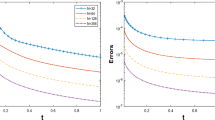Abstract
We present a local exponential fitting hybridized mixed finite-element method for convection–diffusion problem on a bounded domain with mixed Dirichlet Neuman boundary conditions. With a new technique that interpretes the algebraic system after static condensation as a bilinear form acting on certain lifting operators we prove an a priori error estimate on the Lagrange multipliers that requires minimal regularity. While an extension of more classical arguments provide an estimate for the other solution components.
Similar content being viewed by others
References
Arnold D. and Brezzi F. (1977). Mixed and nonconforming finite element methods: implementation, postprocessing and error estimates. RAIRO Modél. Math. Anal. Numér 19: 7–32
Bank R.E., Rose D.J. and Fichtner W. (1983). Numerical methods for semiconductor device simulation. IEEE Trans. Electr. Dev. ED-30: 1031–1041
Bank R.E., Burgler J.F., Fichtner W. and Smith R.K. (1990). Some upwinding techniques for finite element approximation of convection–diffusion equations. Numer. Math. 58: 185–202
Brezzi F. and Fortin M. (1991). Mixed and Hybrid Finite Element Methods. Springer, Heidelberg
Brezzi, F., Marini, L., Micheletti, S., Pietra, P., Sacco, R., Wang, S.: Discretization of semiconductor device problems (I). In: Schilders, W.H.A., Maten, E.J.W. (eds.) Handbook of Numerical Analysis, vol. XIII (Numerical Methods for Electrodynamical Problems). Elsevier Science, Amsterdam (2005)
Brezzi F., Marini L.D. and Pietra P. (1989). Two-dimensional exponential fitting and applications to drift-diffusion models. SIAM J. Numer. Anal. 26(6): 1342–1355
Brezzi F., Marini L.D. and Pietra P. (1989). Numerical simulation of semiconductor devices. Comp. Meth. Appl. Mech. Eng. 75(1–3): 493–514
Ciarlet P.G. (1978). The finite element method for elliptic problems. North-Holland, Amsterdam
Cockburn B. and Gopalakrishnan J. (2004). A characterization of hybridized mixed methods for second order elliptic problems. SIAM J. Numer. Anal. 42(1): 283–301
Cockburn B. and Gopalakrishnan J. (2005). Error analysis of variable degree mixed methods for elliptic problems via hybridization. Math. Comp. 74: 1653–1677
Crouzeix M. and Raviart P.A. (1973). Conforming and nonconforming finite element methods for solving the stationary Stokes equation. RAIRO 7: 33–76
Degond P., Jüngel A. and Pietra P. (2000). Numerical discretization of energy-transport model for semiconductors with non-parabolic band structure. SIAM J. Sci. Comp. 22: 986–1007
Ern A. and Guermond J.-L. (2004). Theory and Practice of Finite Elements. Springer, Heidelberg
Gilbarg D. and Trudinger N.S. (2001). Elliptic partial differential equations of second order. Springer, Heidelberg
Grisvard P. (1992). Singularities in Boundary Value Problems. Springer, Heidelberg
Gopalakrishnan J. (2003). A Schwartz Preconditioner for a hybridized mixed method. Comp. Meth. Appl. Math. 3(1): 116–134
Holst S., Jüngel A. and Pietra P. (2003). Numerical simulation of field-effect transistors using the energy-transport model. SIAM J. Sci. Comp. 24: 2058–2075
Holst S., Jüngel A. and Pietra P. (2004). An adaptive mixed scheme for energy-transport simulations of field-effect transistors. SIAM J. Sci. Comp. 25(5): 1698–1716
Hoppe R. and Wohlmuth B. (1999). A comparison of a posteriori error estimators for mixed finite element discretization by Raviart–Thomas elements. Math. Comp. 68: 1347–1378
Hoteit H., Mosé R., Philippe B., Ackerer Ph. and Erhel J. (2002). The maximum principle violations of the mixed-hybrid finite-element method applied to diffusion equations. Int. J. Numer. Methods Eng. 55(12): 1373–1390
Jüngel A. and Pietra P. (1997). A discretization scheme of a quasi-hydrodynamic semiconductor model. Math. Models Meth. Appl. Sci. 7: 935–955
Micheletti S., Sacco R. and Saleri F. (2001). On some mixed finite element methods with numerical integration. SIAM J. Sci. Comp. 23(1): 245–270
Nicaise, S.: Polynomial interface problems. Peter Lang, Frankfurt am Main (1993)
Marini L.D. and Pietra P. (1989). An abstract theory for mixed approximations of second order elliptic equations. Mat. Aplic. Comp. 8: 219–239
Marini L.D. and Pietra P. (1990). New mixed finite element schemes for current continuity equations. COMPEL 9: 257–268
Polak, S.J., Schilders, W.H.A., Couperus, H.: A finite element method with current conservation. Proc. SISDEP Conf. Bologna 453–462 (1988)
Noyen R.R.P. (1995). A Petrov–Galerkin mixed finite element method with exponential fitting. Numer. Meth. Part. Differ. Eq. 11(5): 501–524
Sacco R. and Saleri F. (1997). Stabilized mixed finite volume methods for convection–diffusion problems. East West J. Numer. Math. 5(4): 291–311
Scharfetter D. and Gummel H.K. (1969). Large-signal analysis of a silicon read diode oscillator. IEEE Trans. Elec. Dev. Ed 16: 64–77
Wang S. and Angermann L. (2003). On convergence of the exponentially fitted finite volume method with an anisotropic mesh refinement for a singularly perturbed convection–diffusion equation. Comp. Meth. Appl. Math. 3: 493–512
Xu J. and Zikatanov L. (1999). A monotone finite element method for convection–diffusion equations. Math. Comp. 68(228): 149–1446
Author information
Authors and Affiliations
Corresponding author
Rights and permissions
About this article
Cite this article
Holst, S. An a priori error estimate for a monotone mixed finite-element discretization of a convection–diffusion problem. Numer. Math. 109, 101–119 (2008). https://doi.org/10.1007/s00211-007-0097-7
Received:
Revised:
Published:
Issue Date:
DOI: https://doi.org/10.1007/s00211-007-0097-7



